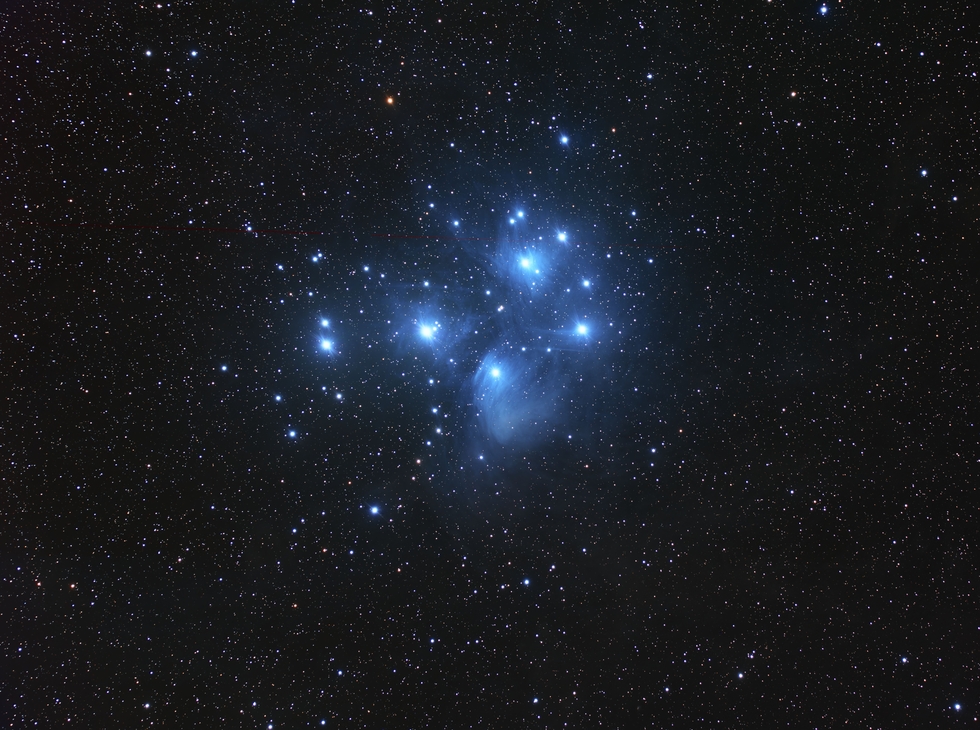M 45
M 45
The Pleiades (also known as the Seven Sisters, the Snail or by the abbreviation M45 in Charles Messier's catalog) is an open cluster visible in the constellation Taurus. This rather close cluster (440 light-years) has several stars visible to the naked eye. In city environments only four or five of the brightest stars can be seen, in a darker place even twelve. All of the components are surrounded by faint reflection nebulae, observable especially in long-exposure photographs taken with sizeable telescopes.
Remarkable is that the stars in the Pleiades are really close to each other, have a common origin, and are gravitationally bound.
Given their distance, the stars visible among the Pleiades are much hotter than normal, and this is reflected in their color: they are blue or white giants; the cluster actually has hundreds of other stars, most of which are too distant and cold to be visible to the naked eye. The Pleiades are a young cluster, with an estimated age of about 100 million years and an expected lifetime of only another 250 million years, since the stars are too far apart
Because of their brilliance and proximity to each other, the brightest stars in the Pleiades have been known since antiquity: they are mentioned, for example, by Homer and Ptolemy. The Nebra disk, a bronze artifact from 1600 B.C. found in the summer of 1999 in Nebra, Germany, is one of the oldest known representations of the cosmos: in this disk, the Pleiades are the third clearly distinguishable celestial object after the Sun and Moon.
Since stars were discovered to be celestial bodies similar to the Sun, people began to speculate that some were somehow related to each other. Through the study of proper motion and the scientific determination of the distances of the stars, it became clear that the Pleiades are indeed gravitationally related and have a common origin
Remarkable is that the stars in the Pleiades are really close to each other, have a common origin, and are gravitationally bound.
Given their distance, the stars visible among the Pleiades are much hotter than normal, and this is reflected in their color: they are blue or white giants; the cluster actually has hundreds of other stars, most of which are too distant and cold to be visible to the naked eye. The Pleiades are a young cluster, with an estimated age of about 100 million years and an expected lifetime of only another 250 million years, since the stars are too far apart
Because of their brilliance and proximity to each other, the brightest stars in the Pleiades have been known since antiquity: they are mentioned, for example, by Homer and Ptolemy. The Nebra disk, a bronze artifact from 1600 B.C. found in the summer of 1999 in Nebra, Germany, is one of the oldest known representations of the cosmos: in this disk, the Pleiades are the third clearly distinguishable celestial object after the Sun and Moon.
Since stars were discovered to be celestial bodies similar to the Sun, people began to speculate that some were somehow related to each other. Through the study of proper motion and the scientific determination of the distances of the stars, it became clear that the Pleiades are indeed gravitationally related and have a common origin
SPECIFICATIONS
Telescope
SPA-1-CMOS
Camera
Takahashi FSQ-106ED
Location
IC ASTRONOMY OBSERVATORY, SPAIN
Date of observation
16-11-2023
Filters
LRGB
Processing
Pixinsight
Credits
Processing Sauro Gaudenzi / DATA Telescope Live


